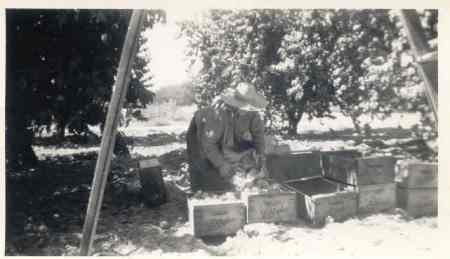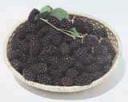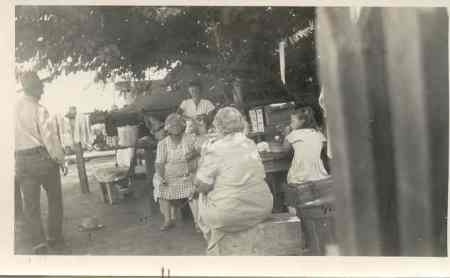
OK, you axed for it! This time it’s peaches! Here’s a photo of Grandma sorting peaches in the boxes.
First, we get out of bed at 6:00 o’clock AM. Then we get dressed, making sure we wear a shirt with long sleeves and tight cuffs. (even though it will be 90 degrees outside today-I’ll explain later) When we leave, we usually wear headgear of some kind; the men, hats and the women, scarves. We eat a good breakfast, usually biscuits and gravy with bacon or sausage, or hotcakes and sugar syrup with a cup of boiled coffee.
Then we drive to the orchard and get a bucket and ladder. The bucket is about a four gallon and has a wire handle with a hook in the middle and the ladder is a 12 or 14 footer. We are, of course, picking peaches.<p>Much of the typical peach picking crews are made up of entire families. We take a set of trees, usually a square of four, then all pick a tree at a time and move around the tree and pick the bottoms then use the ladder to get the fruit from the top and inside the branches. In later years, trees have been “topped” as they are pruned.
But, I’m getting ahead of myself. First we have to plant and grow the trees. Peach trees are set out into orchard plats, usually at least fifteen (?) feet apart to allow for growth. They are flooded to water and after they begin to grow, they have to be hoed to keep weeds out.
I’m a bit vague on this part of raising peaches because I was never involved in the “growing” part of peaches.
The peach trees blossom in the early spring and farmers have to watch them carefully and sometimes use smudge pots placed around and through the orchard to prevent frost from ruining the blossoms. After the buds turn to fruit, (usually in the third or so year, the fruit should be thinned by removing some of it so the rest can get more nutrition and grow larger.
After the trees begin to produce fruit, in the winter they should be pruned; i.e., some limbs and ‘runners’ cut off to insure sunlight gets into the bottom part of the tree and the other limbs get adequate nutrition. And sometimes, if the fruit is very heavy on the limbs, that limb is propped up with a long, narrow board. ‘whew’ There’s more to growing but I know more about the “fun” part, that is, the picking.
OK, I got dressed, washed my hands and face in a wash pan of water that had been heated on the stove, ate breakfast and now we head to the peach orchard.
The roads aren’t very wide at most orchards so people usually drive in from one direction and out the other way. We find the boss and park under trees that have been picked already. (or just out of the way)
We get our trees, sometimes a row or part of a row, pick up a bucket each and a couple of ladders for the family and the kids start on the bottom of the tree and the grownups climb the ladders and get the tops and middles
We have to be careful to not pick fruit that is still green. The bosses will check the fruit to be sure it is all ripe enough. Our while family has been educated as to how ripe and how big the fruit is to be harvested. We have a metal ring that we use to measure the fruit for size. If a peach goes through the ring, it’s too small to pick. That’s called, “ringing” it. ‘duh’
We pick the fruit into the bucket that has a metal handle with a hook on it so it can be hung on a limb. When the bucket is full, it is dumped into a peach box, called a ‘lug’. The weight of the lug of peaches is 45 pounds. The box is called a 45 pound lug. We prefer to pick clingstone peaches rather than freestones because we don’t need to be as careful with them since they’re mostly going to the cannery to be canned. ‘yummy!’
As a lug is filled, the boxes are stacked in rows, usually four or five high, along the road between each odd row. A man drives a truck along the road and checks each lug as he hands it up to another man who loads it onto a flatbed truck. Each box must be loaded right up to the top, checked for too green fruit and ringed for size, to be accepted. If he finds one not up all the way, he takes peaches out of another box to finish it and leaves that box to be re-filled. (That short box is usually quickly filled so all lugs can be taken. It’s a fast operation) We have a punch card the driver punches out to record how many boxes we have. (At the end of the day or job, we go to the boss and he counts the punches in the card and pays us for them.)
We usually pick until noon or so and try to stop for lunch about the same time as everyone else in that orchard. Everyone tries to finish his trees at the same time because we will then move on to another orchard together.
OK, we’ve picked, eaten lunch and picked some more. As anyone who has picked peaches well knows, peaches are covered with very fine stiff hairs called, “Peach Fuzz.” It is a hot day and at the end of the hot, sweaty day, we are covered with dirt and peach fuzz and itching like blazes. (Now you can see why we wear long sleeve shirts with tight cuffs and a collar that can be buttoned tightly; to keep out the peach fuzz!)
Now for the fun part.
If we’re lucky, there is an irrigation canal nearby. If not, we find one that is running with water. When we do, all the kids and most of the grownups jump into the canal of ice cold water, clothes and all! Some folks even bring their soap bars with them. This is how we wash our clothes, bathe and get rid of the peach fuzz, all at the same time! It’s the best part of the day and our wet clothes will be dry by the time we get home.
Then, tomorrow’s another day! Them was, indeed, the good old days and I sure miss them; but not too much! ‘Chuckle’
See ya…







